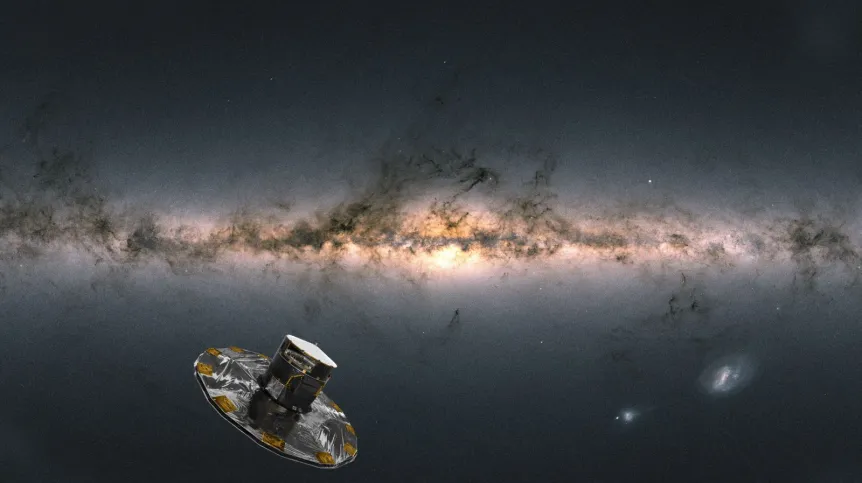
Until now, astronomers had very thorough knowledge of certain fragments of the sky. The Gaia mission gives us the whole sky. It's revolutionary, says Professor Łukasz Wyrzykowski from the Astronomical Observatory of the University of Warsaw.
Earlier this week, a group of over 400 scientists from 24 countries released a data cache containing information about almost two billion objects, mainly stars, as well as the objects in the Solar System and extra-galactic sources. The data were collected as part of the Gaia space mission organized by the European Space Agency (ESA).
The mission objective is to create the most accurate and complete multi-dimensional map of our galaxy - the Milky Way. Ultimately, the map will show the location, speed and direction of movement, brightness, temperature and composition of almost two billion objects in our galaxy and beyond. This information will allow astronomers to reconstruct the past and future evolution of the galaxy over billions of years. The data presented this week constitute the third such set from the mission (Gaia Data Release 3), with detailed information for 1.8 billion stars in the Milky Way.
Professor Łukasz Wyrzykowski from the Astronomical Observatory of the University of Warsaw, who participates in the project, emphasizes that the project has provided a lot of new data, including information about the stars. 'We have a lot of new information about them - we know their colours and chemical compositions. This is a novelty in this catalogue', he said in an interview with journalists after the ESA press conference.
He emphasized that 'the chemistry of our galaxy is fascinating; it is a record of the whole history of the galactic and what will happen to it over the next billions of years. We observe it for a short episode, but with the Gaia data, we are able to examine the chemical compositions and say: this fragment of the sky came from another galaxy, that one is old, and that one is young. It now becomes possible for the whole sky. Until now, astronomers had very thorough knowledge of certain fragments of the sky, Gaia gives us the whole sky. This is a revolution'.
There are 100 billion stars in the Milky Way. 'These two billion stars are the largest catalogue of stars of our galaxy, but at the same time it is only 1 percent of all stars of our galaxy. We get to know more - but it's still not enough', commented Wyrzykowski.
He added that new data collected as part of the Gaia mission would allow to learn much more about our galaxy. "For an ordinary astronomer like me, the enormous amount of these data is overwhelming. The multidimensionality of this information that we release today is so huge that it is difficult to imagine how it will be used', he said and added that every astronomer would find something in this database: information about the minor planets in our solar system, or about dwarf planets located at a long distance.
'The data flow every day. This piece of code I had written must have +understood+ data from the Gaia mission, interpret it and prepare an alert that, for example, something had exploded or disappeared from the sky', said Wyrzykowski, who is also the main author of the catalogue of microlensing phenomena. 'We are trying to use the multidimensionality of data from the Gaia mission to search for black holes with different methods. In this catalogue we present several hundred black hole candidates in binary systems. We also present several hundred candidates for single, lensing black holes. These are new things in which we have been personally involved', he told journalists.
The astronomer has been managing the Polish team involved in the mission for several years. Dr. Milena Ratajczak and Katarzyna Kruszyńska from the Astronomical Observatory of the University of Warsaw are also officially associated with the project. In turn, Krzysztof Nienartowicz works at the Gaia Data Processing Center in Geneva. Many astronomers from Poland also use data from the Gaia observatory.
'This is a revolution', the professor from the University of Warsaw summarized the work carried out as part of the Gaia project. He emphasized that this work also contributes to a revolution in the context of analysing large databases. 'Astronomy has always been in the forefront when it comes to working with big data. The things that are now being done in economics - astronomers were doing 20 years ago. When Gaia was created, we knew that the amount of data generated in the project would be enormous. We said: well, in a dozen or so years, when we will have these data, maybe computers will have +caught up+ and we will be able to analyse these data. And indeed - computers did +catch up+, machine learning tools were developed. They are very much needed in the analysis of such amounts of data', he said.
PAP - Science in Poland, Anna Ślązak
zan/ agt/
tr. RL













